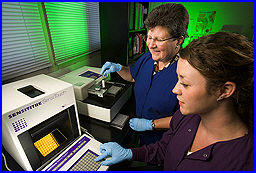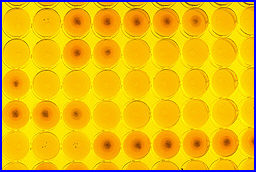



Food Safety: From Farm to Fork
US - Food safety doesn't begin at the grocery store or in the kitchen. It begins on the farm. |
| Research leader Paula Fedorka-Cray (above) and technician Lori Ayers perform antimicrobial susceptibility testing on a plate of bacterial cultures (below). The bacteria were exposed to a range of antimicrobial drugs used in veterinary and human medicine. On the plate of cultures, the darker-orange wells show growth of antimicrobial-resistant bacteria. The lighter-orange wells show no growth, meaning the bacteria were susceptible to the antimicrobials. |
 |
That’s why the Agricultural Research Service (ARS) is in its third year of a multiagency U.S. Department of Agriculture (USDA) effort to routinely track the origins of certain disease-causing bacteria that can occur in meat animal production. The program will also enhance overall understanding of bacteria that pose food safety risks on farms and in processing plants. ARS is the USDA's chief scientific research agency.
In 2003, ARS - along with USDA's Animal and Plant Health Inspection Service and Food Safety and Inspection Service - began what’s called the Collaboration in Animal Health and Food Safety Epidemiology, or CAHFSE (pronounced "calves"), program. The goal is to find out which pathogens are moving from the farm to the processor and then on to retail outlets, according to Paula Fedorka-Cray. She leads the ARS Bacterial Epidemiology and Antimicrobial Resistance Research Unit in Athens, Ga.
Despite significant producer interventions, ongoing research efforts and regular surveillance, outbreaks of foodborne illnesses continue to occur. Also, the emergence of foodborne bacteria that are resistant to multiple antimicrobial treatments has amplified concern.
Hogs are the first production animals to be monitored in the CAHFSE program. A detailed sampling, testing and analytical protocol is being followed across the country to determine the on-farm and in-plant prevalence of Salmonella, Campylobacter, Escherichia coli and Enterococcus bacteria.
Even though the market hog industry has shown dramatic improvement in meeting Salmonella performances standards - by 2005, more than 90 percent met those standards - there is still room for improvement.
Because pathogens change over time, it’s necessary to gather information for a long period of time and across the production spectrum to determine the impact that any particular change in animal health issues or plant production will have on the characteristics of bacteria, such as their prevalence. According to Fedorka-Cray, CAHFSE is a national system that will meet the changing needs of the industry.
ThePoultrySite News Desk








